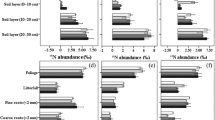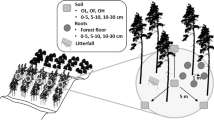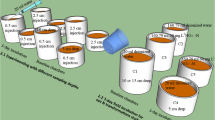Abstract
Natural 15N abundance values were measured in needles, twigs, wood, soil, bulk precipitation, throughfall and soil water in a Douglas fir (Pseudotsuga menziesii (Mirb.) and a Scots pine (Pinus sylvestris L.) stand receiving high loads of nitrogen in throughfall (>50 kg N ha−1 year−1). In the Douglas fir stand δ15N values of the vegetation ranged between −5.7 and −4.2‰ with little variation between different compartments. The vegetation of the Scots pine stand was less depleted in 15N and varied from −3.3 to −1.2‰δ15N. At both sites δ15N values increased with soil depth, from −5.7‰ and −1.2‰ in the organic layer to +4.1‰ and +4.7‰ at 70 cm soil depth in the Douglas fir and Scots pine stand, respectively. The δ15N values of inorganic nitrogen in bulk precipitation showed a seasonal variation with a mean in NH4 +-N of −0.6‰ at the Douglas fir stand and +10.8‰ at the Scots pine stand. In soil water below the organic layer NH4 +-N was enriched and NO3 −-N depleted in 15N, which was interpreted as being caused by isotope fractionation accompanying high nitrification rates in the organic layers. Mean δ15N values of NH4 + and NO3 − were very similar in the drainage water at 90 cm soil depth at both sites (−7.1 to −3.8‰). A dynamic N cycling model was used to test the sensitivity of the natural abundance values for the amount of N deposition, the 15N ratio of atmospheric N deposited and for the intrinsic isotope discrimination factors associated with N transformation processes. Simulated δ15N values for the N saturated ecosystems appeared particularly sensitive to the 15N ratio of atmospheric N inputs and discrimination factors during nitrification and mineralization. The N-saturated coniferous forest ecosystems studied were not characterized by elevated natural 15N abundance values. The results indicated that the natural 15N abundance values can only be used as indicators for the stage of nitrogen saturation of an ecosystem if the δ15N values of the deposited N and isotope fractionation factors are taken into consideration. Combining dynamic isotope models and natural 15N abundance values seems a promising technique for interpreting natural 15N abundance values found in these forest ecosystems.
Similar content being viewed by others
Author information
Authors and Affiliations
Additional information
Received: 5 May 1996 / Accepted: 10 April 1997
Rights and permissions
About this article
Cite this article
Koopmans, C., Dam, D., Tietema, A. et al. Natural 15N abundance in two nitrogen saturated forest ecosystems. Oecologia 111, 470–480 (1997). https://doi.org/10.1007/s004420050260
Issue Date:
DOI: https://doi.org/10.1007/s004420050260




